中考英语知识点:feel用作连系动词的用法 -
feel的用法及短语
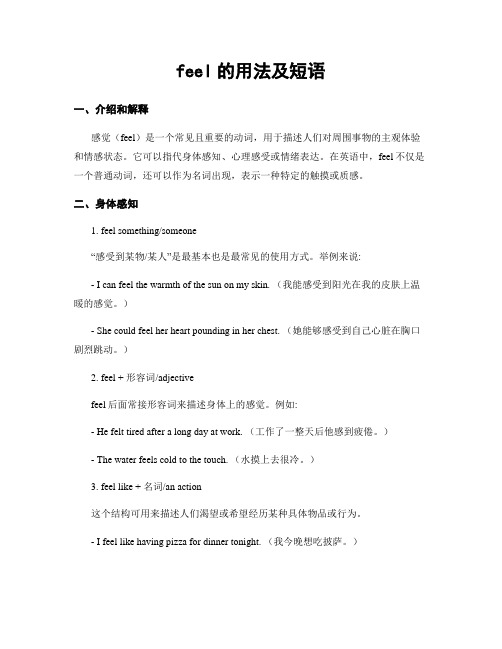
feel的用法及短语一、介绍和解释感觉(feel)是一个常见且重要的动词,用于描述人们对周围事物的主观体验和情感状态。
它可以指代身体感知、心理感受或情绪表达。
在英语中,feel不仅是一个普通动词,还可以作为名词出现,表示一种特定的触摸或质感。
二、身体感知1. feel something/someone“感受到某物/某人”是最基本也是最常见的使用方式。
举例来说:- I can feel the warmth of the sun on my skin. (我能感受到阳光在我的皮肤上温暖的感觉。
)- She could feel her heart pounding in her chest. (她能够感受到自己心脏在胸口剧烈跳动。
)2. feel + 形容词/adjectivefeel后面常接形容词来描述身体上的感觉。
例如:- He felt tired after a long day at work. (工作了一整天后他感到疲倦。
)- The water feels cold to the touch. (水摸上去很冷。
)3. feel like + 名词/an action这个结构可用来描述人们渴望或希望经历某种具体物品或行为。
- I feel like having pizza for dinner tonight. (我今晚想吃披萨。
)- She doesn't feel like going out tonight, so she's staying in. (她今晚不想出去,所以她待在家里。
)三、情感表达1. feel + 形容词/adjective除了用来描述身体感觉,feel也经常用来表示情感状态。
“感到 + 形容词”这个结构通常用于表达某人的情绪或心理状态。
- He felt happy when he received the good news. (收到好消息时他感到开心。
feel 的用法总结 (2)
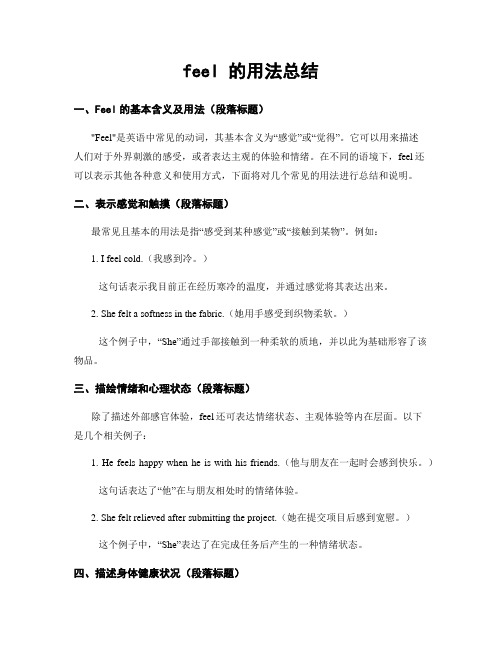
feel 的用法总结一、Feel的基本含义及用法(段落标题)"Feel"是英语中常见的动词,其基本含义为“感觉”或“觉得”。
它可以用来描述人们对于外界刺激的感受,或者表达主观的体验和情绪。
在不同的语境下,feel还可以表示其他各种意义和使用方式,下面将对几个常见的用法进行总结和说明。
二、表示感觉和触摸(段落标题)最常见且基本的用法是指“感受到某种感觉”或“接触到某物”。
例如:1. I feel cold.(我感到冷。
)这句话表示我目前正在经历寒冷的温度,并通过感觉将其表达出来。
2. She felt a softness in the fabric.(她用手感受到织物柔软。
)这个例子中,“She”通过手部接触到一种柔软的质地,并以此为基础形容了该物品。
三、描绘情绪和心理状态(段落标题)除了描述外部感官体验,feel还可表达情绪状态、主观体验等内在层面。
以下是几个相关例子:1. He feels happy when he is with his friends.(他与朋友在一起时会感到快乐。
)这句话表达了“他”在与朋友相处时的情绪体验。
2. She felt relieved after submitting the project.(她在提交项目后感到宽慰。
)这个例子中,“She”表达了在完成任务后产生的一种情绪状态。
四、描述身体健康状况(段落标题)Feel还常用来描述人们的身体健康状况,特别是出现不适或疼痛时。
以下是几个例子:1. I feel tired today after a long day at work.(工作一整天后,今天我感觉很累。
)这句话描写了“我”因为较长时间的工作而感到疲劳。
2. He feels a sharp pain in his leg.(他的腿感到剧烈的疼痛。
)这个例子中,“He”形容了他的腿部有尖锐的疼痛感觉。
五、表示相信和认为(段落标题)除了描述具体感觉和描绘心理状态外,feel还可用于表示相信或认为某事或某种情况是正确或可能发生的。
中考英语专题复习--连系动词look、sound、smell、taste和feel的用法

中考英语专题复习--连系动词look、sound、smell、taste和feel的用法look, sound, smell, taste 和feel它们都属于表示知觉的连系动词。
look的意思:“看起来”、sound的意思:“听起来”、smell的意思:“闻起来”、taste的意思:“尝起来”、feel的意思“摸起来”。
使用时注意以下几点:(1) 通常以物作主语,表示人的知觉状态或感觉能力,虽有被动词味,但不用被动语态。
如:误:The stone is felt smooth.这种石头摸上去很光滑。
正:The stone feels smooth.误:The soup is tasted delicious.这汤味道不错。
正:The soup tastes delicious.(2) 其后均可接like短语。
如:That photograph doesn't look like her at all.那张照片看起来一点都不像她。
This tastes like an orange.这东西吃起来像桔子。
When I realized what stupid mistake I had made, I felt like a fool.当我发现我犯了个愚蠢的错误是,我觉得仿佛是个傻子。
(3) 除look外,均不能接to be,也均不用于进行时态(即使是look 也不多见)。
如:She looks (to be) the right person for this job.她似乎是做这项工作的合适人选。
You look / are looking very fetching in that hat with the purple dress.你戴上那顶帽子配上这紫色衣服显得非常动人。
(4) taste和smell常与of连用,意为“有┅的味道”。
如:The room smelt of cigarettes.房间里有烟味。
feel的用法及搭配
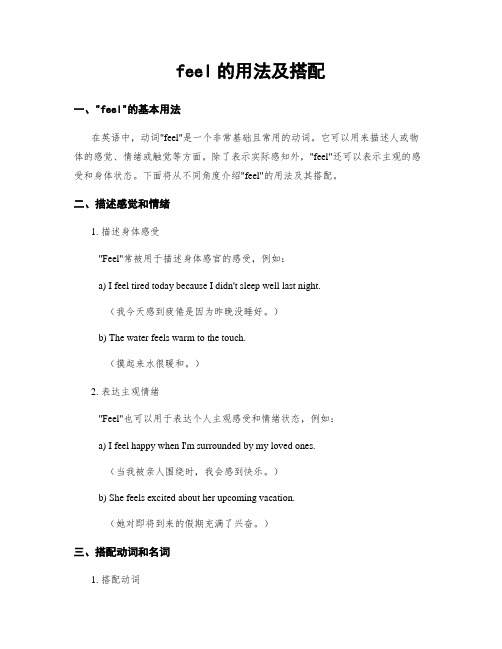
feel的用法及搭配一、"feel"的基本用法在英语中,动词"feel"是一个非常基础且常用的动词。
它可以用来描述人或物体的感觉、情绪或触觉等方面。
除了表示实际感知外,"feel"还可以表示主观的感受和身体状态。
下面将从不同角度介绍"feel"的用法及其搭配。
二、描述感觉和情绪1. 描述身体感受"Feel"常被用于描述身体感官的感受,例如:a) I feel tired today because I didn't sleep well last night.(我今天感到疲倦是因为昨晚没睡好。
)b) The water feels warm to the touch.(摸起来水很暖和。
)2. 表达主观情绪"Feel"也可以用于表达个人主观感受和情绪状态,例如:a) I feel happy when I'm surrounded by my loved ones.(当我被亲人围绕时,我会感到快乐。
)b) She feels excited about her upcoming vacation.(她对即将到来的假期充满了兴奋。
)三、搭配动词和名词1. 搭配动词"Feel"通常与其他动词搭配使用,共同形成不同的意义。
以下是一些常见的搭配动词:a) feel like:感觉像是e.g. I don't feel like going out tonight.(我今晚不想出去。
)b) feel for:同情e.g. I really feel for her loss.(我对她的失去深感同情。
)c) feel about:对...有看法或看待e.g. How do you feel about the new company policy?(你对新公司政策有什么看法?)2. 搭配名词"Feel"也可以与名词搭配,进一步强调感受和情感。
中考英语知识点:feel用作连系动词的用法
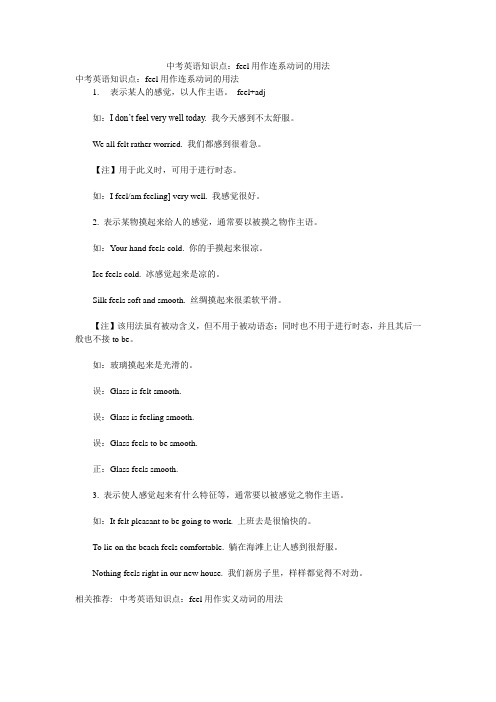
中考英语知识点:feel用作连系动词的用法中考英语知识点:feel用作连系动词的用法1. 表示某人的感觉,以人作主语。
feel+adj如:I don’t feel very well today. 我今天感到不太舒服。
We all felt rather worried. 我们都感到很着急。
【注】用于此义时,可用于进行时态。
如:I feel/am feeling] very well. 我感觉很好。
2. 表示某物摸起来给人的感觉,通常要以被摸之物作主语。
如:Your hand feels cold. 你的手摸起来很凉。
Ice feels cold. 冰感觉起来是凉的。
Silk feels soft and smooth. 丝绸摸起来很柔软平滑。
【注】该用法虽有被动含义,但不用于被动语态;同时也不用于进行时态,并且其后一般也不接to be。
如:玻璃摸起来是光滑的。
误:Glass is felt smooth.误:Glass is feeling smooth.误:Glass feels to be smooth.正:Glass feels smooth.3. 表示使人感觉起来有什么特征等,通常要以被感觉之物作主语。
如:It felt pleasant to be going to work. 上班去是很愉快的。
To lie on the beach feels comfortable. 躺在海滩上让人感到很舒服。
Nothing feels right in our new house. 我们新房子里,样样都觉得不对劲。
相关推荐: 中考英语知识点:feel用作实义动词的用法。
feel的用法和短语
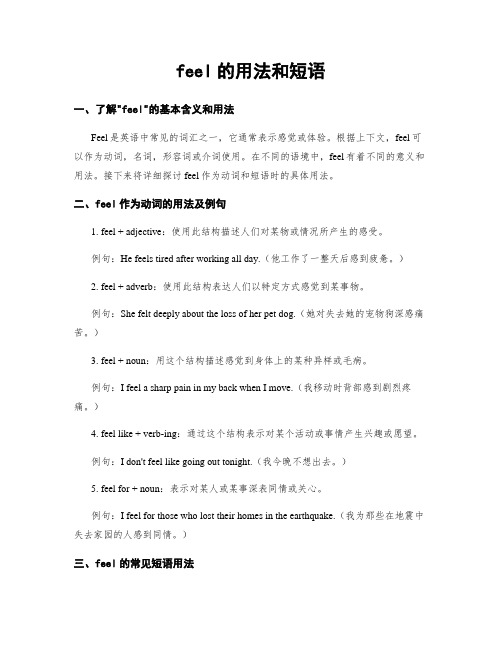
feel的用法和短语一、了解"feel"的基本含义和用法Feel是英语中常见的词汇之一,它通常表示感觉或体验。
根据上下文,feel可以作为动词,名词,形容词或介词使用。
在不同的语境中,feel有着不同的意义和用法。
接下来将详细探讨feel作为动词和短语时的具体用法。
二、feel作为动词的用法及例句1. feel + adjective:使用此结构描述人们对某物或情况所产生的感受。
例句:He feels tired after working all day.(他工作了一整天后感到疲惫。
)2. feel + adverb:使用此结构表达人们以特定方式感觉到某事物。
例句:She felt deeply about the loss of her pet dog.(她对失去她的宠物狗深感痛苦。
)3. feel + noun:用这个结构描述感觉到身体上的某种异样或毛病。
例句:I feel a sharp pain in my back when I move.(我移动时背部感到剧烈疼痛。
)4. feel like + verb-ing:通过这个结构表示对某个活动或事情产生兴趣或愿望。
例句:I don't feel like going out tonight.(我今晚不想出去。
)5. feel for + noun:表示对某人或某事深表同情或关心。
例句:I feel for those who lost their homes in the earthquake.(我为那些在地震中失去家园的人感到同情。
)三、feel的常见短语用法1. feel free:表示对别人的许可,鼓励他们随意做某事。
例句:Feel free to ask any questions you may have.(随时提出任何问题都可以。
)2. feel down:感到沮丧或情绪低落。
例句:She has been feeling down since she failed her exam.(自考试不及格以来,她一直情绪低落。
i feel differently

在九年级英语 unit 1 中有这样一句话:I feel differently. 我第一次看到时,认为是错误的用法,其实不然。
因为以前大多数见到的是连系动词的用法:feel 后面跟形容词作表语,而不是副词作状语。
但是这句话中 feel 的用法,就是作“实意动词”(详见下列第三种用法),所以后面跟副词。
关于feel的用法,一般有以下几种:1 作连系动词:感到、觉得:to feel cold\sick\tired\happy,感到冷、不舒服、累、高兴。
How are you feeling today? 你今天觉得怎么样?You'll feel better tomorrow morning.明天早晨你会好一点的。
2 作连系动词:给人某种感觉:My new coat feels like leather but it's not. 我的新外套摸上去像是皮的,其实不是。
He felt as if he had been there before. 他觉得那个地方似曾去过。
My head feels as though it will burst. 我的脑袋痛得好像快要爆裂似的。
I felt that it was a mistake not to ask her advice. 没有征求她的意见,我认为是个错误。
3 作实意动词:(身体或感情上)感受到、体验到:I felt something crawling up my back. 我觉得有东西爬到我的背上来。
I don't feel any sympathy for Matt at all. 我对马特一点也不同情。
You could feel the tension in the courtroom. 你感觉得到法庭上的紧张气氛。
4 作实意动词:摸、触摸:Feel this material, is it cotton or silk? 摸摸这块布料,看看是棉布还是丝绸?I felt her forehead to see if she had a temperature. 我摸了摸她的前额,看看她是不是在发烧。
feel系动词的用法
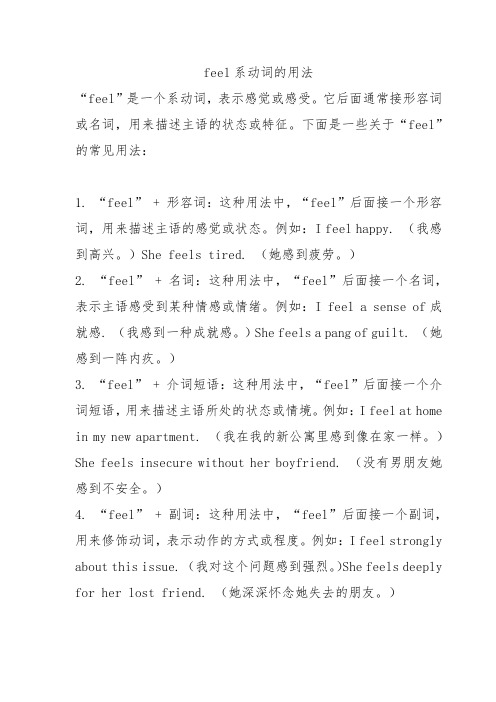
feel系动词的用法“feel”是一个系动词,表示感觉或感受。
它后面通常接形容词或名词,用来描述主语的状态或特征。
下面是一些关于“feel”的常见用法:1. “feel” + 形容词:这种用法中,“feel”后面接一个形容词,用来描述主语的感觉或状态。
例如:I feel happy. (我感到高兴。
)She feels tired. (她感到疲劳。
)2. “feel” + 名词:这种用法中,“feel”后面接一个名词,表示主语感受到某种情感或情绪。
例如:I feel a sense of成就感. (我感到一种成就感。
)She feels a pang of guilt. (她感到一阵内疚。
)3. “feel” + 介词短语:这种用法中,“feel”后面接一个介词短语,用来描述主语所处的状态或情境。
例如:I feel at home in my new apartment. (我在我的新公寓里感到像在家一样。
)She feels insecure without her boyfriend. (没有男朋友她感到不安全。
)4. “feel” + 副词:这种用法中,“feel”后面接一个副词,用来修饰动词,表示动作的方式或程度。
例如:I feel strongly about this issue. (我对这个问题感到强烈。
)She feels deeply for her lost friend. (她深深怀念她失去的朋友。
)总之,“feel”是一个非常常用的系动词,它可以用来描述主语的感觉、情感、状态和情境等。
在使用时需要根据具体语境选择合适的用法。
- 1、下载文档前请自行甄别文档内容的完整性,平台不提供额外的编辑、内容补充、找答案等附加服务。
- 2、"仅部分预览"的文档,不可在线预览部分如存在完整性等问题,可反馈申请退款(可完整预览的文档不适用该条件!)。
- 3、如文档侵犯您的权益,请联系客服反馈,我们会尽快为您处理(人工客服工作时间:9:00-18:30)。
中考英语知识点:feel用作连系动词的用法中考英语知识点:feel用作连系动词的用法
1. 表示某人的感觉,以人作主语。
feel+adj
如:I dont feel very well today. 我今天感到不太舒服。
We all felt rather worried. 我们都感到很着急。
注】用于此义时,可用于进行时态。
如:I feel/am feeling] very well. 我感觉很好。
2. 表示某物摸起来给人的感觉,通常要以被摸之物作主语。
如:Your hand feels cold. 你的手摸起来很凉。
Ice feels cold. 冰感觉起来是凉的。
Silk feels soft and smooth. 丝绸摸起来很柔软平滑。
注】该用法虽有被动含义,但不用于被动语态;同时也不用于进行时态,并且其后一般也不接to be。
如:玻璃摸起来是光滑的。
误:Glass is felt smooth.
误:Glass is feeling smooth.
误:Glass feels to be smooth.
正:Glass feels smooth.
3. 表示使人感觉起来有什么特征等,通常要以被感觉之物作主语。
如:It felt pleasant to be going to work. 上班去是很愉快的。
To lie on the beach feels comfortable. 躺在海滩上让人感到很舒服。
Nothing feels right in our new house. 我们新房子里,样样
都觉得不对劲。
